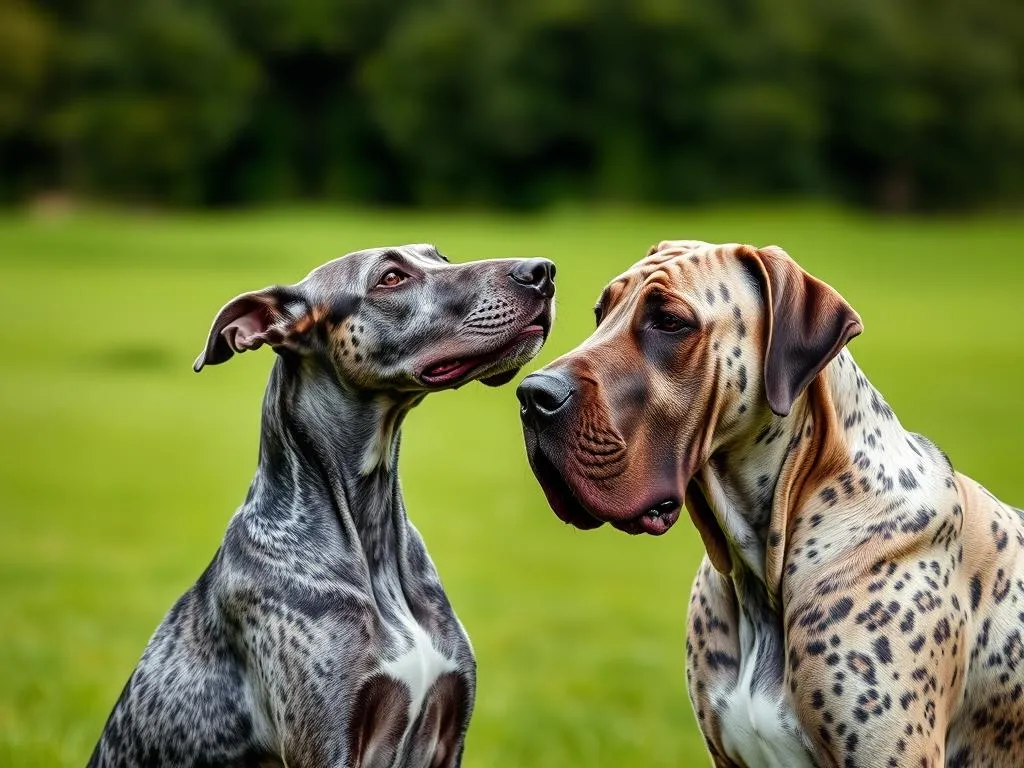
Dogs have long been cherished companions, offering loyalty, protection, and love. Among the myriad of breeds, the Irish Wolfhound and Great Dane stand out as two of the largest and most majestic. While both breeds share a gentle temperament and striking appearance, their histories, characteristics, and needs vary significantly. This article delves into a detailed comparison of these two breeds, providing insights to help potential dog owners make informed decisions.
Overview of the Breeds
Irish Wolfhound
The Irish Wolfhound is steeped in rich history, dating back to ancient times in Ireland. Originally bred for hunting wolves and large game, this breed is known for its impressive stature and gentle nature.
Physical Characteristics: Irish Wolfhounds typically stand between 30 to 34 inches tall, weighing between 120 to 180 pounds. They have a rough, wiry coat that can come in various colors, including gray, brindle, red, black, and fawn.
Temperament: Known for their calm demeanor, Irish Wolfhounds are gentle giants. They are friendly, affectionate, and often form strong bonds with their families. Their protective instincts also make them excellent watchdogs, though they are not aggressive.
Great Dane
The Great Dane, often referred to as the “Apollo of dog breeds,” has its roots in Germany. Initially bred to hunt boar, they have evolved into loving family pets and show dogs.
Physical Characteristics: Great Danes typically measure between 28 to 34 inches at the shoulder, with weights ranging from 100 to 175 pounds. They possess a short, smooth coat, available in various colors, including fawn, brindle, blue, black, and harlequin.
Temperament: Despite their imposing size, Great Danes are known for their friendly and affectionate nature. They are social and enjoy being around people and children, making them great family pets. Their playful demeanor often surprises those who expect a more serious disposition.
Size and Appearance
Size Comparison
| Breed | Height (inches) | Weight (pounds) |
|---|---|---|
| Irish Wolfhound | 30-34 | 120-180 |
| Great Dane | 28-34 | 100-175 |
Both breeds are colossal, but the Irish Wolfhound tends to be taller on average, while the Great Dane may be slightly heavier.
Coat and Color Variations
Irish Wolfhound coats are typically rough and wiry, requiring moderate grooming. Common colors include gray, brindle, red, and black.
In contrast, Great Danes have short, smooth coats that are easier to maintain, with popular colors being fawn, brindle, blue, and harlequin. Both breeds shed, but the Great Dane’s grooming needs are less demanding compared to the Irish Wolfhound.
Temperament and Behavior
General Temperament
Both breeds share a friendly disposition. Irish Wolfhounds are known for their calm and laid-back nature, often preferring to lounge around the house. They are gentle with children and other pets, making them excellent family companions.
Great Danes, on the other hand, are more playful and energetic. They enjoy engaging in activities with their families and are known for their goofy antics that can bring joy to any household. Both breeds thrive on companionship and can become anxious if left alone for extended periods.
Socialization Needs
Socialization is crucial for both breeds. Early exposure to various environments, people, and other animals is essential to ensure they grow into well-adjusted adults.
For Irish Wolfhounds, gentle training and positive reinforcement work best, while Great Danes respond well to structured training and socialization classes. Both breeds benefit from regular interaction with other dogs to develop healthy social skills.
Health Considerations
Common Health Issues
While both breeds are generally healthy, they are susceptible to specific health issues.
Irish Wolfhounds often face problems such as bloat (gastric torsion), heart issues, and certain cancers. Their large size can also lead to joint problems.
Great Danes are prone to hip dysplasia, heart disease, and certain types of cancers. Their size makes them more vulnerable to bloat as well, which requires careful management of their feeding and exercise routines.
Lifespan
Irish Wolfhounds typically have a lifespan of 6 to 10 years, which is shorter than many other breeds. In contrast, Great Danes generally live between 7 to 10 years. Factors affecting longevity include genetics, diet, exercise, and regular veterinary care.
Exercise and Lifestyle Needs
Activity Level
Both breeds require regular exercise, but their needs differ slightly.
Irish Wolfhounds enjoy moderate exercise, such as daily walks and some playtime in a secure area. They are not as high-energy as other breeds, but they do need regular physical activity to maintain a healthy weight.
Great Danes require more vigorous exercise and enjoy activities like running and playing fetch. Daily walks and playtime are necessary to keep them physically and mentally stimulated.
Living Environment
While both breeds can adapt to various living situations, they thrive in homes with ample space.
Irish Wolfhounds can manage in apartments if given enough exercise, but they prefer homes with large yards.
Great Danes also do well in larger homes but need sufficient room to move comfortably. Both breeds should not be left outside for extended periods; they are people-oriented and need to be with their families.
Cost and Maintenance
Initial Purchase Price
The cost of acquiring either breed varies significantly based on factors like breeder reputation, location, and lineage.
Irish Wolfhounds typically cost between $1,500 to $2,500, while Great Danes range from $1,000 to $3,000. Prospective owners should also consider adopting from shelters or breed-specific rescues, which can lower initial costs.
Ongoing Costs
Ongoing expenses for both breeds can add up due to their size.
- Food: Both breeds require high-quality dog food tailored to their size and age. Expect to spend $60 to $120 per month.
- Grooming: Irish Wolfhounds may require more grooming, which can cost $50 to $100 quarterly, while Great Danes may cost $30 to $80.
- Veterinary Care: Regular check-ups, vaccinations, and emergency care can range from $300 to $800 annually depending on health needs.
Ideal Owners
Who Should Consider an Irish Wolfhound
Irish Wolfhounds are best suited for families or individuals who appreciate a calm, gentle companion. They thrive in environments where they can spend time with their owners and are not ideal for those who want a highly active dog. Owners should have a moderate level of experience with larger breeds, as training and socialization will be necessary.
Who Should Consider a Great Dane
Great Danes are perfect for families who enjoy a playful, affectionate dog. They require active owners who can provide regular exercise and mental stimulation. Ideal owners should appreciate a dog with a big personality and be prepared to accommodate their size in living arrangements and lifestyle.
Final Thoughts
In summary, both the Irish Wolfhound and Great Dane are exceptional breeds that offer unique traits and temperaments. While they share similarities in size and gentle nature, their health needs, exercise requirements, and overall lifestyles differ. Potential dog owners should carefully evaluate their living situations, activity levels, and preferences to choose the breed that best fits their lifestyle.
Both breeds make wonderful companions, and considering adoption from shelters or rescues can provide a loving home to dogs in need.
FAQs
What is the average weight of an Irish Wolfhound?
The average weight of an Irish Wolfhound ranges from 120 to 180 pounds.
How much exercise does a Great Dane need daily?
A Great Dane typically requires at least 1-2 hours of exercise daily, including walks and playtime.
Are both breeds good with children?
Yes, both Irish Wolfhounds and Great Danes are known for their gentle and friendly nature, making them excellent companions for children.
What are the grooming needs for each breed?
Irish Wolfhounds require regular grooming to manage their wiry coat, while Great Danes have lower grooming needs due to their short coat.
Conclusion
Choosing between an Irish Wolfhound and a Great Dane ultimately comes down to personal preference, lifestyle, and comfort with handling large breeds. Each breed has its unique charm and characteristics, making them both excellent companions for the right owner. Take the time to research and consider which breed aligns with your lifestyle and family dynamics, and enjoy the rewarding experience of dog ownership.









